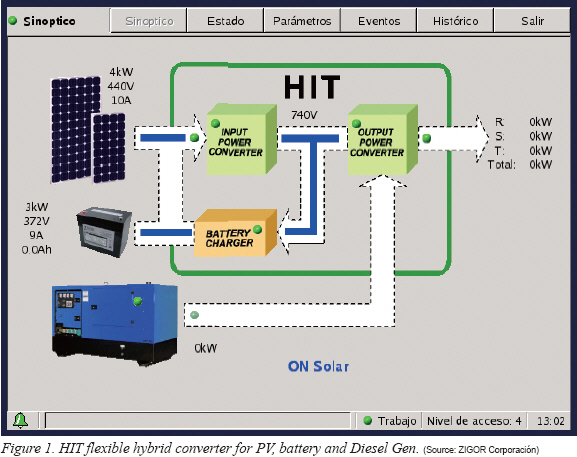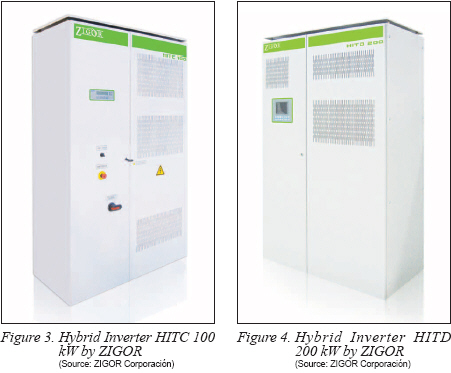By Jose Luis Iribarren, Dr. Raquel Ferret
Market Needs and Technological Drivers
The cost reduction of solar and wind energy forms of electricity generation, together with the world initiative and concern with CO2 emissions reduction and environmental barriers to expand existing grid infrastructures, are slowly facilitating the development of new more atomized forms of distributed generation, which are increasingly green-based.
Renewable energy sources are, unfortunately, neither manageable nor available on demand. So, some forms of storage or hybridizing with other sources of generation are required to guarantee the demand, which normally follows a totally different profile to the generation one.
Static power electronic converters are challenging traditional generation techniques, especially when energy storage and active regulation are a must, either to balance demand and generation or to mix green-based sources with fuel-based forms if possible. Altogether, these new world circumstances are changing the way that the energy and electricity industry will develop in the near future. ZIGOR has been investing and developing new concepts and solutions to facilitate the integration of the new economically feasible forms of energy generation.
This is also driven by higher levels of availability and the international need to increase energy efficiency.
Energy Hybridization and Storage
Flexible DC & AC/DC/AC converter capable of processing both DC and AC forms of energy, opens new fields of energy management and energy storage As an example, in Figure 1, we present the HITC system, a hybrid inverter for off-grid applications that is also capable of continuously regulating the energy flows from different inputs (generation) to the multiple outputs (consumer).

The simple idea of combining fuel-based and renewable sources in alternating or direct current forms is today very commonly done by integrating standard existing products available in the market. However, what ZIGOR introduces as innovation is the possibility to continuously add energy to meet the demand of user from the available energy sources: grid, generator, solar, wind and battery, and do that following a customizable or cost function defined to have the lowest possible cost of the demanded energy.
Application and Architecture
Starting from this general hybridization concept, ZIGOR has developed a series of products to fulfill different customers, requirements, which means to adapt this concept to different power values, solar and/or wind resources as well as the physical grid distribution.
Telecom Hybrid Off-Grid
Hybrid topologies are normally designed to bring energy to remote sites where the grid is not available and therefore energy supply is a challenge in terms of reliability, maintenance and cost. Thus, this is the most common application of hybrid off-grid systems being typical examples: remote telecom, as the one presented in Figure 2, or utility sites, small rural villages, water pumping, etc.

Many different combinations of input energy sources can be used with ZIGOR HITC & HITD Hybrid Inverters Series, which are very flexible and scalable to meet growing energy demand over the time.
Utilities Compatible with Rural Electrification
The HITC (Hybrid Inverter for Three phase Centralized micro-grid) has been especially designed for this application, suitable for small villages and small and medium industries where power availability from the grid is low. In Figure 3, you can see the HITC (Hybrid Inverter for Centralized Off-grid applications) for 100 kW nominal power.
The ability of the HITC to manage the energy irrespective of the utility or the renewable source combined with a battery back-up (for unpredictable peak demands), also offers a valuable UPS function to critical load.
Notice that this configuration is also useful in places where obtaining higher levels of power from the utility is impossible due to limits of the infrastructure or impossibility to upgrade the existing lines because of environmental restrictions.
Distributed Micro Grids, Fuel and CO2 Saving
When combining renewable energy and battery power with either grid or diesel generated power, the physical distribution of both the generation and the consumers, many times cover large areas, especially in remote rural electrification.
To deal with this situation ZIGOR has introduced another innovative hybrid system, the HITD (Hybrid Inverter for Three phase Distributed micro-grid) in the power range of 200 kVA to 1600 kVA. The HITD inverter Series allows scattered distribution of the generation and loads along the distribution grid maintaining the grid stability. In Figure 4 you can see the HITD (Hybrid Inverter for Distributed Off-grid applications) for 200 kW nominal power.

Energy Storage Managing Renewable Resources
This function is probably the biggest challenge that the world is facing today--to let the renewable sources grow to compete with traditional forms of generation.
Our new reversible inverter (battery charger/on-grid inverter) called BATGEN brings to the market an opportunity to store energy in different battery technologies in the power range of 100 kVA to multi MVA facilitating the manageability and dispatchability of renewable generation plants.
Jose Luis Iribarren is Electrical Engineer, specialized in Electricity at ETSII of San Sebastian (Basque Country University, Spain) and has worked as the R&D Director at ZIGOR Corporacion (www.zigor.com) since 1998. Formerly he worked as Chief of Research and Development Activities for Saft Iberica, Chief of R&D of Saft Nife Iberica and was responsible for Technological Strategy at Saft International. Iribarren has participated in several national and international research projects and he holds several patents.
After Dr. Raquel Ferret majored in Chemistry in 1994 in the Basque Country University, Spain, she worked as research assistant in the Chemical Engineering Department in the field of catalyst and environmental issues where she completed a Ph.D. in 2000. She, then, worked at TEKNIKER in the area of tribology, lubricants and fuels and moved onto surface chemistry research and life cycle assessment issues, participating and coordinating several national and international projects. In 2006, she joined ADIGEST as Technological Consultant and International Projects Coordinator and in 2008 she joined ZIGOR Corporacion as Innovation Project Coordinator.
For more information, please send your e-mails to pved@infothe.com.
ⓒ2011 www.interpv.net All rights reserved. |



